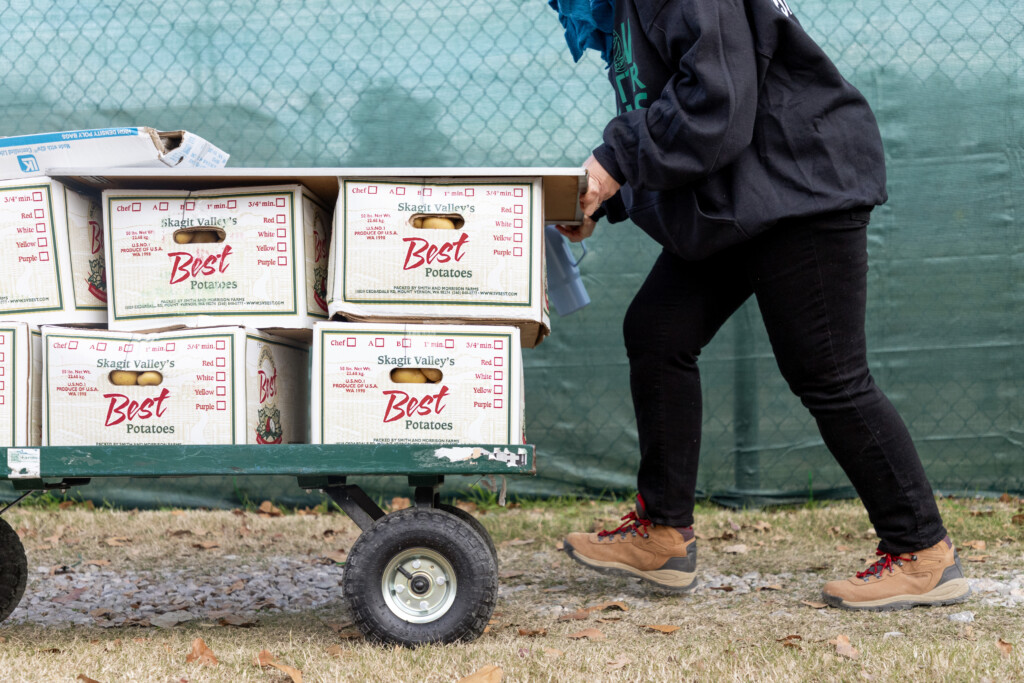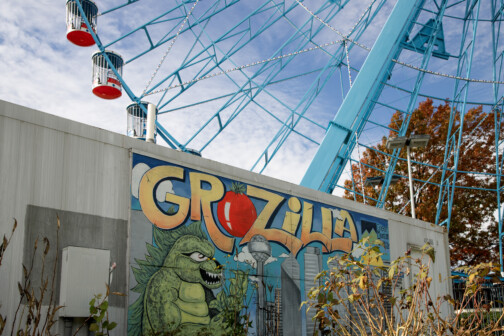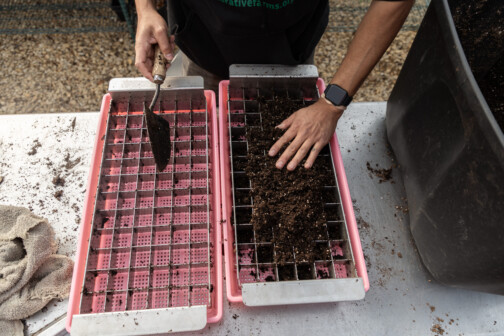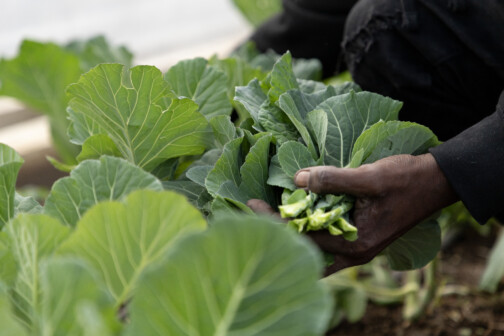On Tuesdays, workers from Restorative Farms wind through the streets of Fair Park until they reach the Midway, where their next harvest lies.
Their destination is a shipping container in the shadow of the Texas Star Ferris Wheel. Its name is Grozilla, a hydroponic farm inside a 15-ton container next to the Errol McKoy Greenhouse that produces fresh produce each week. Restorative Farms co-founder Brad Boa cleans his shoes on the anti-microbial mat and sanitizes his hands. Any trace of bacteria or bugs could ruin an entire harvest.
On a rainy spring day, Boa’s gray hair is slicked back to show a face framed by black-rimmed glasses. In place of his dark blue hoodie, he slips on a white lab coat and then opens the door.
He enters a room with a walkway and rows of produce on either side bathing in purple LED light. Four rows of dark green lettuce heads are stacked on top of one other, each row at a different stage of growth. The temperature is set to between 72 and 74 degrees to ensure each of the heads can thrive in their platform of shallow water, no matter the outside temperature.
It takes 28 days for the produce to grow in its container to be ready for harvest. When the yield is ready, workers will pluck somewhere around 300 heads of lettuce or of whatever other vegetable they decide to grow that season.
Restorative Farms is an urban farm with projects in Fair Park and South Dallas. Its goal is to help provide a structure for this part of town to rely on its own food system through multiple versions of urban agriculture, such as seedling farms and hydroponic grow operations like Grozilla. The result is fresh, locally grown produce for the community it serves.
“This is just different kinds of farming, and this will be the future of farming,” he says. “There’s going to be huge need for this kind of technology in the future.”
The city of Dallas is paying attention. This past spring, City Hall adopted the Comprehensive Urban Agriculture Plan to outline goals and recommendations to boost urban farm development. It aims to improve access to healthy foods in neighborhoods that don’t have grocery stores. It also hopes to motivate restaurants to buy local when possible, reducing the distance between ingredient and table. The plan was part of the Dallas Comprehensive Environmental & Climate Action Plan, or CECAP, which was approved in May 2020. It called for improving access to fruits, vegetables, and other healthy options.
Restorative Farms has a similarly ambitious mission. The lettuce heads harvested from Grozilla are moved from Fair Park onto a truck to help feed the South Dallas community, of which portions are federally designated food deserts. At any given time, produce from Dallas’ urban agriculture farms could end up in the kitchen of a restaurant or in a local grocery store. What urban agriculture presently brings to the table is only the beginning.
The concept of urban agriculture isn’t new, but it has gained popularity in recent years because of increased urbanization, limited access to fresh and nutritious food, environmental concerns, and the demand for sustainable and locally sourced fruits and vegetables.
Restorative Farms was started to create a template for urban farming that would impact the city’s food system in a positive way. The mission came from the results of an SMU participatory research project led by professor Owen Lynch. The results concluded the community wanted help in creating a local farm system.
Boa met Lynch and co-founders Tyrone Day and Doric Earle, another SMU professor who was working with Fraizer Revitalization to develop community entrepreneurial programs. They each quickly aligned with the organization’s purpose.
The name comes from Day’s story. In 1990, Day was advised by his defense attorney to plead guilty to a sexual assault crime despite him maintaining his innocence. For more than a decade, Day’s requests for DNA testing were denied. His case was picked up by the Innocence Project in 2004, and DNA testing later proved he was not involved in the crime. He was released in 2015 and exonerated earlier this year.
Day studied horticulture at Trinity Valley Community College while he was incarcerated. He brought his knowledge back to his community. After he was released, Day, Boa, Lynch, and Earle started Restorative Farms.
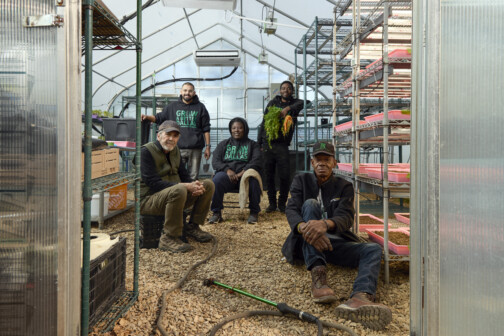
Restorative began with a seedling farm in 2017 at the MLK Community Center in a former community garden that Boa says was more common to find dry and deserted rather than flush with greens. SMU invested in the project and donated a grant to help get the farm started. The team used a greenhouse to help plants go from seed to sprout. Farmers, customers, or restaurateurs who wanted seedlings could purchase them to grow their own produce.
“This whole arc of producing food from seed to produce—that seedling stage is one of the hardest,” Boa says. “So, if you could remove that, it’d make it easier for someone who wants to accomplish actually growing food.”
They wanted to create the foundation of an urban agricultural system within the city limits. In 2019, the organization began raising money and received a larger donation from Frazier Revitalization, a nonprofit organization dedicated to developing and engaging the Frazier neighborhood in southeast Dallas. Restorative Farms leases just under half an acre from Dallas Area Rapid Transit, which sometimes sells off or leases unused lots or land that were left over after building out the region’s light rail system. The lot, adjacent to Hatcher Station, has now grown into about an acre of in-ground growing and teaching space where seedlings from the MLK Seedling Farm can turn into a food source. Hatcher Station was recently approved for a greenhouse that can produce up to 2,500 heads of greens each week.
During the pandemic, the model shifted with the launch of GroBox, a planter starter kit made of a wooden planter box and seedlings from the MLK Seedling Farm. They were assembled at Hatcher Station Farm with help from furloughed farmers. All proceeds go back to the farm.
Grozilla’s hydroponic farming entered the picture in 2020. Instead of transporting seedlings from farm to farm, the hydroponic produce can grow from seed to harvest in one place. It also became a place for workers to experiment with microgreens. Learning and teaching is a major part of Restorative Farms’ mission of building an agriculture system, whether it’s inside Grozilla or at Hatcher Station. Their effort has created a ripple effect.
Many seedlings from Restorative Farms go to Joppy Momma’s Farms. Joppy Momma’s operates in Joppa, another Dallas neighborhood south of Interstate 30 whose history is riddled with food insecurity, low wages, pollution, and health problems. The former freedman’s town also has a rich history and highly engaged residents who are working to improve its conditions. These include people like Kimberly High, who grew up in Joppa. She and many of her family members are diabetic. In fact, the last person in her lineage without the disease was her great-grandmother, whom the community called “Joppy Momma.” The farm now sits on land where her home used to be, the same soil where Joppy Momma used to grow her own food.

High was diagnosed with diabetes about 10 years ago. She decided to take her health seriously after being told she would need to take insulin three times a day. High began volunteering at Bonton Farms just north of Joppa and later left her full-time job at Allstate after 31 years to manage an extension of Bonton. High then moved to Paul Quinn in 2020 to help with the school’s We Over Me Farm, an old football field that had been converted into an urban farm. After years of working at these urban farms, High learned her family still had property in Joppa.
“I’m thinking to myself, ‘Oh, no way,’” High says. “I’m all over the city helping people create healthy places to eat, and I can just come home and do it in my own neighborhood.”
The produce from Joppy Momma’s goes back into Joppa. On the property, High has built above-ground boxes that grow onions, potatoes, and rows of broccoli and kale. A chicken coop is in the works. In the back, she has a small hive for local honey. She says it’s worked miracles for her allergies. At some point, she wants to start a bistro to serve food from the garden.
Joppy Momma’s also sells produce to local chefs. Restaurant Beatrice, a Cajun restaurant near the Bishop Arts District that prides itself on sustainability, buys from Joppy Momma’s and was also the first restaurant account for Restorative Farms. Beatrice chef Michelle Carpenter coordinates with High to see what produce she has in stock. If Carpenter sees something she likes, she’ll try to incorporate it into the menu. Sometimes, Carpenter will give High a list of produce to see if she can grow it.
Food scraps from Beatrice wind up back at Joppy Momma’s for composting. The evidence is in the dirt: oyster shells were recently scattered about the property, and heaps of compost produce rich soil for the food that will help shape the menu at Restaurant Beatrice.
“That’s the full circle,” Carpenter says. “We support them, they support us.”
The primary CECAP goal is to reduce greenhouse emissions, but the seventh piece of the plan is to ensure all communities in Dallas have access to healthy and local food.
The city enlisted help from consultants like Agritecture Consulting and TBG Partners, as well as other sustainable food groups that determined the current state of urban agriculture in Dallas. They also devised a plan to create a system to scale. Mikel Wilkins, an environmental engineer at TBG Partners, and Jeffrey Landau of Agritecture spent about 18 months surveying local urban farms and stakeholders before landing on goals and recommendations for the Comprehensive Urban Agriculture Plan.
They found that the city has about 15 to 16 acres of urban agriculture production in the form of vertical production, warehouse farms, community gardens, rooftop farms, hydroponics, aeroponics, and aquaponic facilities. Most of these farms are nonprofits.
Wilkins estimates the agriculture plan team met with at least 15 city departments to address how permitting and land availability affected urban agriculture. This process led to one of the first recommendations of the plan: to reduce the number of barriers created by rules and regulations, which tend to dissuade potential farmers from pursuing urban agriculture projects.
“As we analyzed some of the roadblocks and barriers to implementation that relate to land development code and things like that, it was great to be able to work with them and let them know what we were seeing as barriers,” Wilkins says.
The state of Texas also recently weighed in on the matter.
In November, voters approved Proposition 1, a constitutional amendment that protects urban farmers working within city limits. In 2021, a farmer in Farmers Branch disputed a city code ordinance that required grass in vacant lots within city limits to be no more than 8 inches tall. The farmer said he was growing the grass to turn into hay bales. Proposition 1 would protect farmers in those situations, within reason. Municipalities are required to provide “clear and convincing evidence” if any kind of regulation against farming is needed. The setbacks for urban farming growth are a bit more complicated, and could be why Dallas is trailing other large Texas cities.
“If we made it easier to have access to these assets, like land and water, people might find it easier to get involved in this space.”
Rabekha Siebert, urban agriculture coordinator for the City of Dallas
In 2021, there were 54 community gardens in Dallas among 1.2 million people, according to the agriculture plan. Austin and Houston have almost double the number of community gardens relative to their populations.
Dallas made its first effort to support urban agriculture in 2010 by passing an ordinance intended to help community farms. Little happened. A 2014 analysis found that high costs and a confusing permitting process had hamstrung the effort. Rabekha Siebert, the city’s urban agriculture coordinator, is working to solve these challenges. She was hired in March 2022, and in her first month, she worked with Agritecture to conduct meetings and interviews with stakeholders to inform her strategy.
The plan outlines specific targets for local food access. Its goal by 2050 is to ensure that 100 percent of Dallas’ population have access to healthy and affordable food. It seeks to increase acreage of urban farms by 75 percent and boost production on those farms by 75 percent.
Local food systems are fragile, and they are often impacted by incremental weather and geopolitical issues. A pandemic or natural disasters, Siebert notes, can drastically impact how food gets from one place to another. Creating a strong agricultural system within Dallas could help soften the blow.
“It reduces our ability to be impacted by some external factors,” she says. “You’re no longer externalizing your resources or your production, you’re now internally creating that supply.”
Land is always needed. Even if the existing 16 or so acres of urban farms in Dallas were producing at their maximum capacity, it would still only feed a small portion of our population, Siebert says. The biggest challenge is cultivating available land and finding the people to do it. To Siebert, the challenge is also a cultural issue.
The average age of a farmer is 58 years old and getting older. To produce food, there must be someone to grow, tend to, and harvest the land in those areas. There aren’t many people—young people in particular—who are interested in doing that in urban areas, Siebert says.
“Food is grown in rural spaces and transported in, but if we have a huge population shift in the cities, we need to be cultivating more space to grow food in cities to account for the lack of people in rural spaces growing food,” she says. “However, we don’t exactly have people knocking on doors to get access to land. If we made it easier to have access to these assets, like land and water, people might find it easier to get involved in this space.”
There still appears to be general interest in urban agriculture among Dallas residents. A survey conducted by the city of Dallas found that more than 70 percent of respondents were interested in volunteering, learning, or working in gardening or farming. The best way to support urban agriculture efforts, residents answered, is for the city to provide money and resources.
Siebert says the Office of Environmental Quality and Sustainability offers resources and events to help farmers navigate regulatory barriers within the city, such as website design and grant writing. In the works is a grower’s education and workforce development program in tandem with UT Arlington, which would supply farms with paid interns or apprentices to help with production.
“I have this belief that where money goes, hearts and minds follow.”
Brad Boa
While education is important, it’s not exactly a career path on its own. Boa believes creating a workforce is key to showing younger people that urban farming can be a way to make a living. He hopes to see an agriculture system that rewards people for production rather than relying on volunteers.
“I have this belief that where money goes, hearts and minds follow,” he says. “If you can help people understand that production is more than just creating a Facebook picture, that it’s actually production that engages people and creates jobs, that’s different.”
Urban agriculture creates jobs, a local sustainable food source, and helps bring communities together. Restorative Farms employs five full-time workers, and Boa says the Restorative Farms team has plans to partner with more restaurants in Dallas. Since the Hatcher Station Farm started, Boa says he’s heard anecdotes from neighbors who feel that crime in the area has decreased.
It also has its limitations. Farming hard, grueling work, and there isn’t a U.S. city that has been able to successfully pioneer the idea to its fullest extent. There are excellent models, though: Atlanta, Detroit, Toronto, San Francisco, and Boston have incorporated urban agriculture into city policies. Austin has a community garden program and a coalition to sustain it. Philadelphia’s urban agriculture program establishes projects on the city’s parkland. Boa thinks Dallas has an opportunity to do more.
In the past, Boa has seen community gardens with dying or weed-filled beds because nobody was taking care of them. It’s not until someone invests money, resources, time, and people to help cultivate the land that there can be some form of success or resiliency. Boa believes this is the only way forward.
“I do wake up in the middle of the night or four in the morning going, ‘What’s the impact?’” he says. “But then there’s a question I use to justify what I think is the lack of effectiveness: ‘What’s the best time to plant a tree?’ Twenty years ago. We’re planting that tree now.”
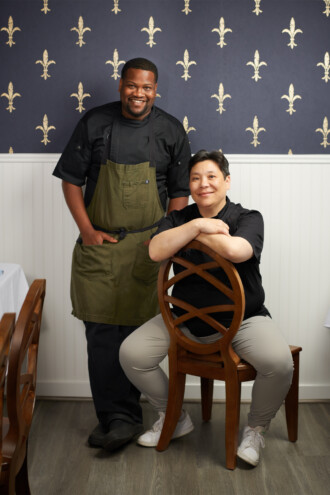
When she’s not creating dishes or thinking of how to change up her menu, chef Michelle Carpenter is trying to reduce Restaurant Beatrice’s carbon footprint.
Some restaurants or grocery stores will receive shipments of produce via trucks or planes that crisscross the country. Food waste is a constant problem for restaurants. That’s an issue, Carpenter says, but using local farms and fresh produce is an important beginning step. Joppy Momma’s is roughly 8 miles from Restaurant Beatrice, a distance that eliminates the middleman and cuts carbon emissions. Carpenter believes a little can go a long way.
This year, Beatrice purchased beets, carrots, collards, turnips, eggplant, and muscadines from Joppy Momma’s Farms. The muscadines were canned and preserved. The beets were used in the baby beet salad.
The restaurant also receives goods from a variety of urban, community, and hydroponic farms such as Profound Farms, which grows more than 150 varieties of greens, herbs, and edible flowers in a hydroponic farm in Lucas. It sells to restaurants like Petra and the Beast and José.
Carpenter has a wide variety of leafy greens and other vegetables from which to choose, and she does so with pride. She markets her restaurant’s insistence on local suppliers, explaining its importance in marketing materials and on the menu itself. In the restaurant’s 2023 impact report, Beatrice noted it was composting 100 percent of its food waste—some of which end up at Joppy Momma’s—and that all of their fryer oil and cardboard is recycled. The restaurant also partners with Barrier Beauties for oysters and Ocean Beauty for seafood, both of which are based in Galveston. They’re also working to source from local ranchers for protein and continuing to build relationships with local urban farmers.
Carpenter says choosing which farms to work with means receiving fresh ingredients that will put their dollars in the right place: back into the community. It doesn’t hurt that it also helps create a sustainable food system for Dallas.
“For Kim, she’s trying to do it for her community, to educate her community, and trying to make her community better,” Carpenter says of High and Joppy Momma’s. “We want to make sure we’re having an impact by choosing the right people to work with.”
List of urban agriculture projects and farms in Dallas:
Restorative Farms, Hatcher Farm and Seedling Farm Dallas, 4527 Scyene Rd.
Bonton Farms, 6911 Bexar St.
Oak Cliff Veggie Project
Big Tex Urban Farms, located inside Fair Park.
Half Acre Farm, 13545 Fernheath Ln.
Jubilant Fields Farm (Profound Foods), 13067 E. Line Rd., Trenton.
Elmwood Farm, 1014 Nolte Dr.
Clarification: A person in one of the photos was misidentified in an earlier version of this story.
Author



